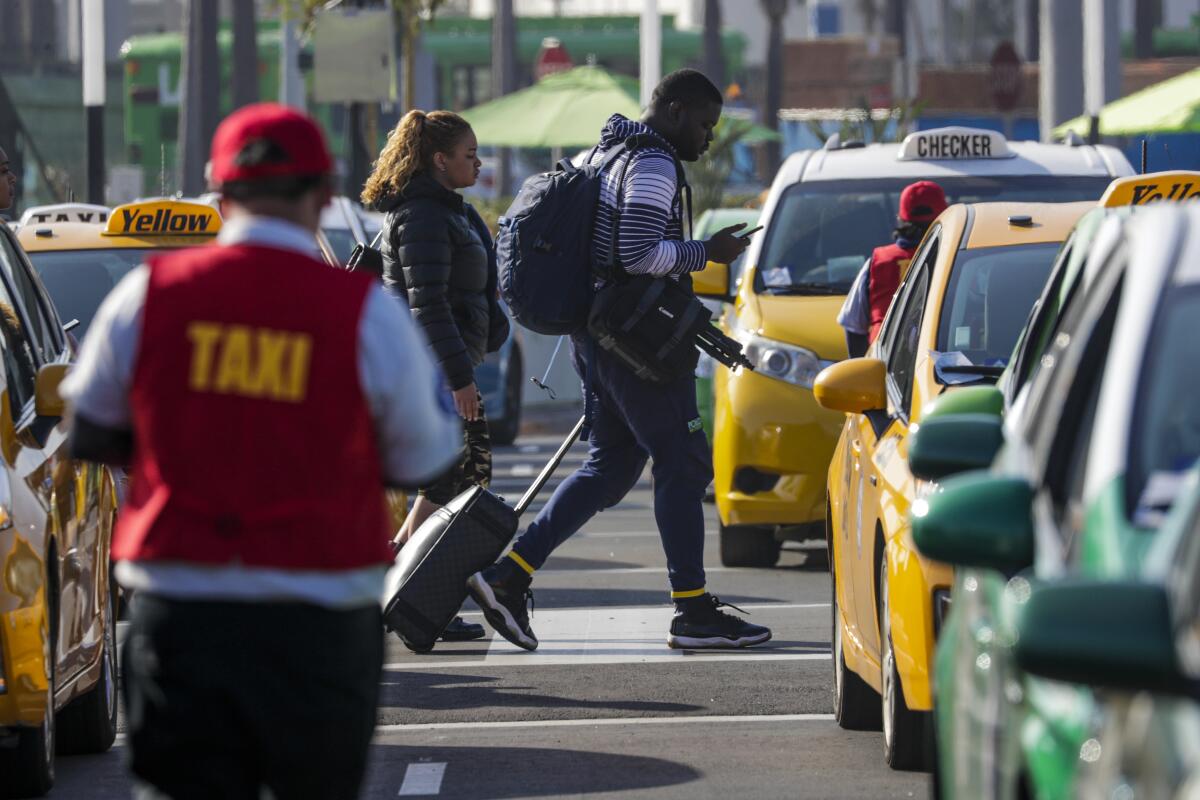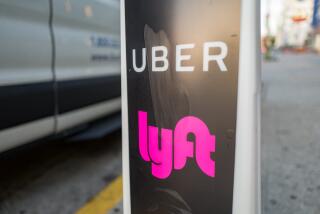If you can’t save money, time or the planet with Uber and Lyft, what’s the point?

- Share via
Sunday night, I flew into LAX from San Francisco and boarded a shuttle to the airport’s newish pickup spot for ground transportation just east of Terminal 1. I found myself standing amid an unhappy crowd of restless travelers who had been waiting as long as 30 minutes to be picked up by their Lyft drivers.
Weird, I thought. Not how it’s supposed to be.
Then I checked my phone for prices, which vary according to which Lyft service you want to use: a shared ride is cheaper than a ride in a luxury vehicle. A “priority pickup” costs more but arrives sooner, in theory anyway.
The fees to get from LAX to my home six miles away were stunning. They ranged from $59 to $108. Two days earlier, my Lyft ride from Venice to LAX cost $41.59.
What the heck?
My Lyft history shows I took my very first ride on the service on May 19, 2015. I paid $8.43 to get to the airport. A cab would have cost around $35.
Lyft seemed too good to be true. Maybe it was.
Over the years, my Lyfts to LAX hovered around $20. On Feb. 23, 2020, I took my last ride to the airport before the pandemic lockdown ended most travel. The bill: $24.24.
It’s no surprise that on-demand rides are more expensive now than they were in the early, heady days of Lyft and its larger competitor, Uber. The pandemic put the brakes on all sectors of transportation. Without passengers, the need for drivers plunged.
Now that people are traveling again, there is a shortage of drivers.
I have no problem with the concept of price being governed by supply and demand, nor even with the practice of surge pricing, which is what I faced Sunday night at LAX.
But surge pricing only makes sense (at least to me) if there are no better alternatives. I glanced over at the taxi line. People were hopping into cabs and taking off, bam, bam, bam. Should I join them? Bit of a dilemma for me.
I swore off taxis years ago after I realized that every time I walked out of an LAX terminal toward the taxi line, my neck and shoulders began to tense. I was bracing for a fight.
I knew there was a good chance my cabbie would be annoyed that I live so close to the airport. Or that he would mistakenly head to Van Nuys instead of Venice. Or that he would pretend his meter was broken.
I knew the driver would ask me to pay in cash, that I would decline and he would probably be surly about it. Sometimes drivers were downright nasty; one took it out on me by driving like a maniac. I came close to jumping out of his car when he stopped for a red light at Jefferson and Sepulveda boulevards.
To head off the inevitable unpleasantness, the moment I stepped into a cab, I took to announcing that my company required me to use a credit card.
With Lyft, it felt so liberating to bypass all that drama and simply tap an app on my phone.
Yes, I was participating in the decimation of an industry built on the hard work of so many immigrants — and that did not feel great — but I was helping clean up the environment, reducing traffic and getting a bargain in the process, wasn’t I?
Well, no.
Thanks to many studies in recent years, we know now that the promises from founders of rideshare businesses were nothing but pie-in-the-sky fantasies.
In 2015, Uber founder Travis Kalanick gave a TED talk in which he vowed the new rideshare business model would get “more people into fewer cars,” dramatically reduce air pollution and, as he put it, “reclaim our cities today.”
At a San Francisco tech conference that year, Kalanick also said: “If every car in San Francisco was Ubered, there would be no traffic. If everyone in the city took an Uber instead, it would give back an hour of time every day to every person. What would you do with that time? You could give it back to your family.”
He was so, so wrong.
An abundance of research has shown that Uber and Lyft create congestion in the already overcrowded downtown streets of big cities and add to pollution.
In San Francisco, home to both companies, traffic speeds plummeted, mostly because of Uber and Lyft, according to a study in the journal Science Advances.
A new study from Carnegie Mellon University confirms what the California Air Resources Board has said: Rideshare drivers in major cities cruise around without passengers 40% of the time.
And multiple studies have found that people use Uber and Lyft instead of public transportation or walking. Last year, California air quality officials said that the more than 600,000 ride-hail vehicles in the state emit about 50% more greenhouse gases per passenger mile traveled than an average car. My colleague Tony Barboza reported that the Union of Concerned Scientists concluded that the ride-hailing trip is actually 70% more polluting than the average car trip it replaces.
As the Wall Street Journal put it in February 2020: “The reversal of ride-hailing from would-be traffic hero to congestion villain is the sort of unintended consequence that has become a recurring feature of Silicon Valley disruption. Companies seeking rapid growth by reinventing the way we do things are delivering solutions that sometimes create their own problems.”
In retrospect, it seems silly to have been taken in by the fantasy that putting more cars on the road would reduce the number of cars on the road.
On Sunday, I decided to forego the long wait for a Lyft and the absurdly high congestion pricing. I hopped into a cab and was home in 15 minutes. The tab: $34.69.
The driver asked me for cash, of course.
But when I brandished my credit card, he did not utter a peep of protest. Maybe — just maybe — I have Uber and Lyft to thank for that.
More to Read
A cure for the common opinion
Get thought-provoking perspectives with our weekly newsletter.
You may occasionally receive promotional content from the Los Angeles Times.











